Understanding and Addressing Egg Eating in Chickens
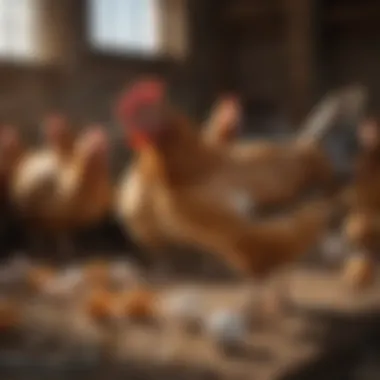
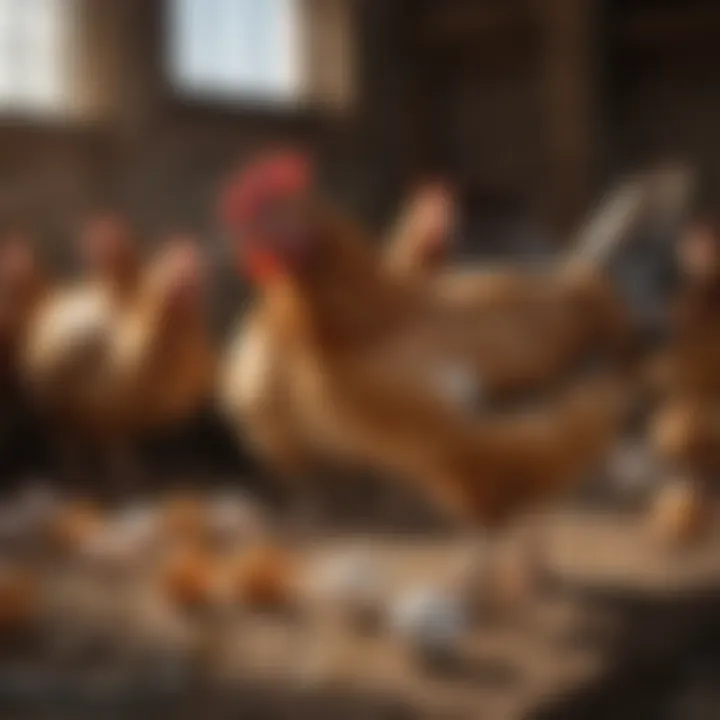
Intro
Egg eating is not just a quirky behavior in chickens; it’s a significant concern for poultry farmers. Many keepers discover, often too late, that their hens have turned to consuming their own eggs. This issue, while seemingly innocuous at first, can lead to serious ramifications for the flock, affecting its overall health, productivity, and economic viability.
Understanding the underlying causes of egg eating in chickens is essential. It is not simply a matter of appetite but often reflects broader environmental or physiological issues. Identifying these triggers is key to addressing the problem effectively.
Prelims to Egg Eating in Chickens
The behavior of chickens eating their own eggs poses a significant challenge for poultry keepers. Understanding this issue is crucial for several reasons. First, it impacts the productivity and welfare of the flock. Eggs not only represent a source of income but also a measure of the overall health and well-being of the chickens. Second, addressing egg eating is essential for the stability of the flock’s social structure. Left unchecked, this behavior can lead to increased stress and discord among the chickens, which may further exacerbate the problem.
In this article, we will scrutinize different aspects of egg eating in chickens. This includes identifying the root causes, recognizing the signs, and implementing effective strategies to prevent and manage the issue. The goal is to present an evidence-based, detailed guide that empowers poultry keepers with the knowledge and tools necessary to mitigate this troubling behavior.
Defining the Problem
Egg eating is not merely a nuisance; it is a behavior that arises from a complex interplay of factors. Chickens may consume eggs due to nutritional deficiencies, environmental stressors, or intrinsic behaviors rooted in their instincts. Understanding how these variables interact can help in developing targeted solutions. For instance, chickens lacking essential vitamins or minerals might resort to egg eating as an alternative source of nutrients. Additionally, overcrowding in the coop can lead to heightened stress levels and disrupt the social order, prompting this maladaptive behavior.
Clearly defining egg eating within the context of poultry management allows for a better grasp of why this behavior occurs and establishes the foundation for effective interventions.
Scope of the Issue
The prevalence of egg eating in chicken flocks can vary based on numerous factors, including breed predisposition, housing conditions, and the management practices employed by poultry keepers. Reports of egg eating are not isolated incidents; they represent a broader issue that affects flock health across diverse operations.
Egg eating is often underreported, and many poultry keepers might miss the signs until the behavior becomes ingrained. Its impact can also lead to substantial economic losses. For some farms, the financial implications may be significant enough to consider altering flock management strategies entirely. Recognizing and addressing this issue within the broader context of poultry agricultural practices ensures a more sustainable approach to flock welfare and productivity.
"Understanding egg eating in chickens is crucial for maintaining a healthy flock and ensuring sustainable farming practices."
Common Causes of Egg Eating
Understanding the common causes of egg eating in chickens is crucial for effective management. Identifying these causes can help poultry keepers implement targeted strategies to alleviate the issue. Egg eating not only affects production but can also lead to a decline in the overall health of the flock. Addressing these root causes can foster a more harmonious environment.
Nutritional Deficiencies
Nutritional deficiencies are significant factors that can lead to egg eating behaviors. Chickens need balanced nutrition to maintain health and productivity. Inadequate diets can result in poor development and aberrant behaviors.
Importance of Calcium
Calcium plays a critical role in egg production and overall chicken health. It is essential for the formation of strong eggshells. When calcium levels are insufficient, hens may become more inclined to eat their eggs. Providing adequate calcium helps avoid this problem. Owners can offer sources like crushed oyster shells or limestone as supplements. A good calcium supply reduces the risk of egg-related issues and ensures strong eggshells.
Protein Requirements
Adequate protein is also essential for chickens. It supports growth and egg production. If hens do not receive enough protein, they may resort to eating eggs as a source of nutrients. Including high-protein feed options, such as soy or fish meal, can help prevent protein deficiencies. Sufficient protein intake promotes better health, hence reduces egg eating tendencies.
Environmental Factors
The environment where chickens are kept plays an important role in their behavior. Stress and overcrowding can contribute to egg eating. Addressing environmental factors can have a positive impact on chicken behavior and wellbeing.
Crowding and Stress
When chickens are overcrowded, it can lead to frustration and aggressive behavior. This stress can trigger egg eating as they search for alternative activities. Providing ample space is crucial for reducing stress among the flock. Creating a calmer environment can enhance overall behavior and decrease the likelihood of egg eating incidents.
Coop Conditions
Coop conditions directly influence the chickens' comfort and health. Proper ventilation, cleanliness, and protection from predators can affect their stress levels. If coop conditions are subpar, chickens may feel unsafe, leading to maladaptive behaviors such as egg eating. Maintaining an adequate and clean coop environment is essential for reducing egg eating tendencies. Managing coop conditions proactively can lead to more healthy and productive birds.
Instinctual Behavior
Some behaviors, such as pecking order dynamics and nesting patterns, stem from instinct. These instincts can influence egg consumption. Understanding these innate behaviors allows poultry keepers to implement effective solutions.
Pecking Order Dynamics
The pecking order is an essential aspect of chicken social structures. Dominant birds may disrupt others, leading to stress. Sometimes hens may eat eggs due to competition or frustration from their place in the pecking order. A careful evaluation of flock dynamics can help identify issues. Implementing strategies that manage pecking order stress can improve overall flock harmony.
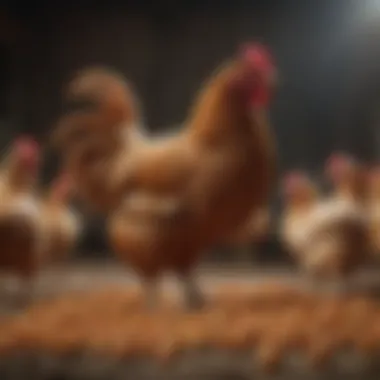
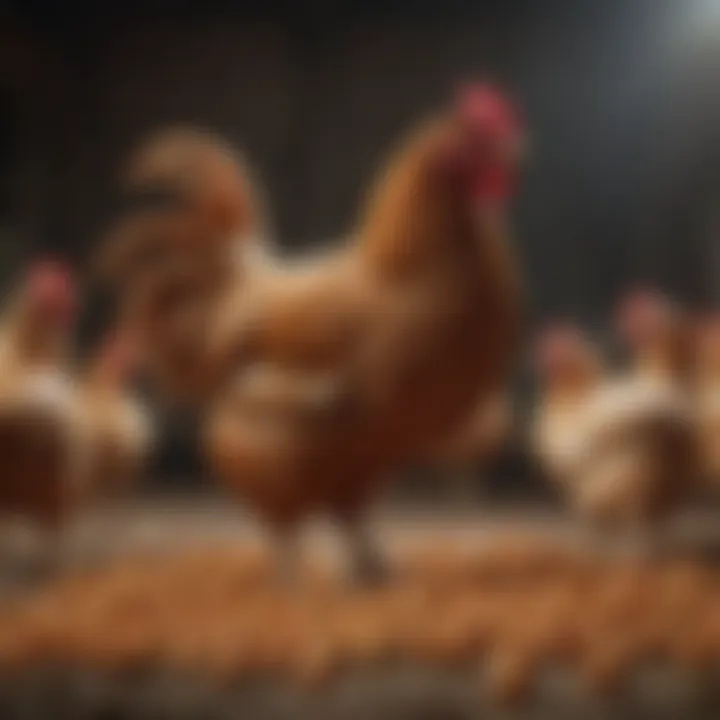
Nesting Behavior
Nesting behavior is another instinctual pattern among chickens. If hens feel their nesting area is inadequate, they may resort to eating their eggs out of distress. Providing suitable nesting boxes can help mitigate this behavior. Ensuring a comfortable and secure nesting space can lead to reduced instances of egg eating. Monitoring hens during their nesting periods will also shed light on any stressors affecting their behavior.
Identifying Signs of Egg Eating
Recognizing the signs of egg eating in chickens is essential for effective management. Identifying these indicators early can help in adjusting strategies to prevent this behavior from becoming a habit. The implications of egg eating can lead to decreased egg production, impacting both the health of the chickens and the productivity of the poultry farm. By understanding the behavioral indicators and physical evidence of egg eating, poultry keepers can tackle the issue promptly.
This section explores critical signs to monitor, which include behavioral indicators and physical evidence that signal potential egg eating.
Behavioral Indicators
Monitor Pecking Behavior
Monitoring pecking behavior is a comprehensive method for discerning potential egg eating. Chickens exhibit natural pecking, yet changes in this activity can indicate a problem. If you notice persistent pecking at nesting boxes or other chickens, it may be a warning sign.
This practice is beneficial because it allows poultry keepers to get acquainted with the normal pecking patterns of their flock. Understanding what is normal helps to differentiate between healthy behavior and one that may be problematic. Regular monitoring provides valuable insight into the dynamics within the flock, enabling effective intervention when necessary.
However, only keeping watch for intensified pecking might not yield immediate corrective actions unless combined with other indicators of egg eating. The challenge lies in distinguishing between harmless pecking and destructive behavior.
Tracking Egg Production
Tracking egg production plays a crucial role in identifying egg eating incidents. A drop in egg production can be one of the first signs that a chicken is consuming its own eggs. By regularly recording the number of eggs collected, you will pinpoint any sudden declines that may necessitate further investigation.
This method is practical and straightforward, offering an immediate way to assess flock health. Keeping detailed logs allows for an easy review of trends over time, which can reveal patterns in egg laying that may correlate with other observed behaviors.
Yet, while tracking egg production is vital, it should be combined with other observations like behavioral changes. Sole reliance on production numbers alone may lead to overlooking other critical factors influencing flock dynamics.
Physical Evidence
Physical signs can be indicative of egg eating and should not be overlooked. Two primary types of physical evidence are cracked shells and shell remnants.
Cracked Shells
Cracked shells serve as a significant indicator of egg eating. When hens consume their eggs, the resulting broken shells can often be found within the coop. This physical evidence directly links to the behavior at hand, making it an important characteristic of the issue.
Finding cracked shells can raise immediate concerns for poultry keepers. Not only does it spotlight the possibility of egg eating, but it also creates an opportunity for farmers to assess the overall health and well-being of their chickens. If cracked shells are identified regularly, it signals a need for further exploration into the causes behind the behavior.
However, cracked shells can also result from numerous factors, including improper handling or environmental stresses, which may complicate the diagnosis of egg eating.
Shell Remnants
Shell remnants are another crucial aspect to consider. These elements can provide insight into the egg-eating behavior seriously. When chickens eat their eggs, small pieces of the shells can be present in nesting areas, further confirming consumption has occurred.
The presence of shell remnants can serve as a warning flag that immediate action is required. This evidence gathers together with other indicators, allowing for a multifaceted view of the situation. As well, it can help in discussions with other poultry keepers about potential solutions or management strategies.
While shell remnants provide valuable information, they might not always be definitive proof of egg eating. Other environmental influences certainly need to be considered, highlighting the importance of a comprehensive approach to identify and manage this issue.
By synthesizing behavioral indicators and physical signs, poultry keepers can better understand the dynamics contributing to egg eating, allowing them to act before it becomes a larger problem.
Preventative Measures
Preventative measures play a crucial role in addressing the issue of egg eating in chickens. The behavior can stem from various causes including nutritional deficiencies and environmental stressors. By taking a proactive approach, poultry keepers can create a healthier environment that mitigates this behavior before it becomes a widespread issue. Implementing these measures not only improves the welfare of the chickens but also enhances productivity in terms of egg production.
Optimizing Nutrition
Balanced Diet Formulation
Balanced diet formulation is fundamental to overall chicken health and well-being. A diet that is well-rounded in nutrients helps chickens grow strong and maintain essential bodily functions. The key characteristic of balanced diet formulation is the inclusion of proteins, carbohydrates, vitamins, and minerals in the right proportions. Feeding chickens a balanced diet significantly reduces the risk factors that lead to egg eating.
One unique feature of a balanced diet is its adaptability to different life stages of chickens. For example, layers require more calcium compared to broilers. This adaptability makes balanced diets beneficial for poultry keepers. However, one potential disadvantage can arise from the cost and effort involved in sourcing the right ingredients to ensure the diet remains balanced.


Supplemental Calcium Sources
Supplemental calcium sources are important for preventing egg eating caused by calcium deficiency. Calcium plays a vital role in the formation of strong eggshells, making it a key element in poultry nutrition. A high-quality calcium source, such as crushed oyster shells or limestone, can be easily incorporated into the chicken’s diet.
These supplements are beneficial as they provide the necessary calcium without needing to dramatically change the entire feeding strategy. Additionally, providing supplemental calcium can lead to an increased egg production rate, which is desirable for many chicken keepers. However, over-supplementation may lead to health complications, so it is important to monitor the amounts provided.
Enhancing Coop Environment
Space Requirements
Space requirements directly affect the comfort and behavior of chickens. Chickens that are kept in overcrowded conditions often experience heightened stress levels, which can lead to cannibalistic behaviors, including egg eating. Providing ample space allows the chickens to roam freely and promotes a more relaxed environment.
The unique feature of space requirements is its direct correlation with the density of the flock. Adhering to suggested space guidelines can significantly reduce stress. However, ensuring an adequate space range can be challenging and may not be feasible for all poultry keepers, especially those with limited physical space.
Proper Ventilation
Proper ventilation in a coop is essential for preventing negative health impacts associated with poor air quality. Good ventilation helps regulate temperature and allows for the circulation of fresh air, which can reduce stress among the flock. Proper ventilation ensures that humidity levels remain low and that harmful gases, like ammonia, are expelled from the living area.
The major benefit of proper ventilation is its role in enhancing overall flock health. Chickens in a well-ventilated coop are less likely to exhibit undesirable behaviors, including egg eating. An aspect to consider is that maintaining ventilation systems might require ongoing monitoring and adjustments, especially in changing weather conditions.
Effective management of coop conditions and nutrition are integral aspects of preventing egg eating in poultry.
By understanding the underlying causes and implementing these preventative measures, poultry keepers can create a more conducive environment for their chickens. This, in turn, fosters the well-being of the flock and promotes sustainable poultry farming.
Management Strategies for Egg Eating
Understanding management strategies for egg eating in chickens is significant for poultry keepers. These strategies help address the problem by implementing tailored interventions. When done correctly, these measures can drastically reduce egg consumption among the flock. Overall, a systematic approach to management can improve the health and productivity of the chickens.
Behavior Modification Techniques
Behavior modification techniques directly target the actions of chickens that lead to egg eating. This section explores two key strategies: distraction methods and adjusting nesting areas.
Distraction Methods
Distraction methods are behavioral interventions used to redirect the chickens’ attention from eggs to more appropriate activities. This technique is beneficial as it encourages natural behaviors, preventing the fixation on egg consumption.
A key characteristic of distraction methods is their reliance on engaging the chickens through environmental stimuli. By introducing new elements into the coop, such as pecking blocks or hanging vegetables, chickens can be diverted. This encourages exploration, reducing the likelihood of egg eating.
Unique features of distraction methods include their low cost and ease of implementation. However, the effectiveness can diminish if chickens become accustomed to the distractions. Therefore, regularly changing these elements can be crucial to maintaining their interest.
Adjusting Nesting Areas
Adjusting nesting areas involves creating a more conducive environment for egg-laying. This strategy aims to reduce stress on hens and encourages healthy nesting behaviors. A beneficial choice for addressing egg eating, adjusting nesting areas focuses on enhancing privacy and comfort.
The key characteristic of this method includes placing nesting boxes in quieter, lower-traffic parts of the coop. This environment allows hens to feel safe when laying eggs, minimizing disturbances that could lead to egg consumption.
The unique feature of adjusting nesting areas is that it can directly impact egg-laying habits. By ensuring hens have a dedicated and peaceful space, the desire to eat their eggs may reduce. On the downside, placing nesting boxes in new locations requires careful monitoring to ensure that hens still use them.
Providing Enrichment
Providing enrichment is vital in preventing egg eating by promoting overall well-being in chickens. This section will cover access to foraging and toys and interaction, which are significant to fulfilling chickens’ natural behaviors.
Access to Foraging
Access to foraging allows chickens to engage in a natural activity essential for their mental and physical health. Foraging contributes to the overall goal of preventing egg eating by keeping chickens occupied and less focused on their eggs.
A key characteristic of this approach is allowing chickens to explore a designated area outside the coop or to provide materials that mimic a natural environment. This promotes instinctive behaviors, relieving stress and boredom that lead to egg eating.
The unique feature of access to foraging is its long-term benefits on flock behavior. Chickens that have ample opportunity to forage are generally healthier and more satisfied. However, there can be challenges like managing access to prevent escapres or injuries.
Toys and Interaction
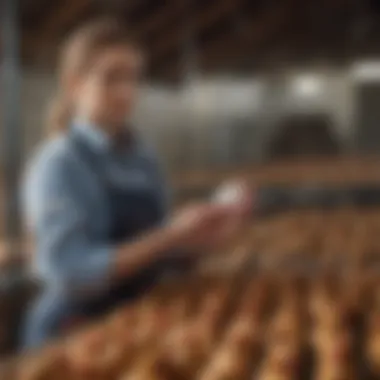
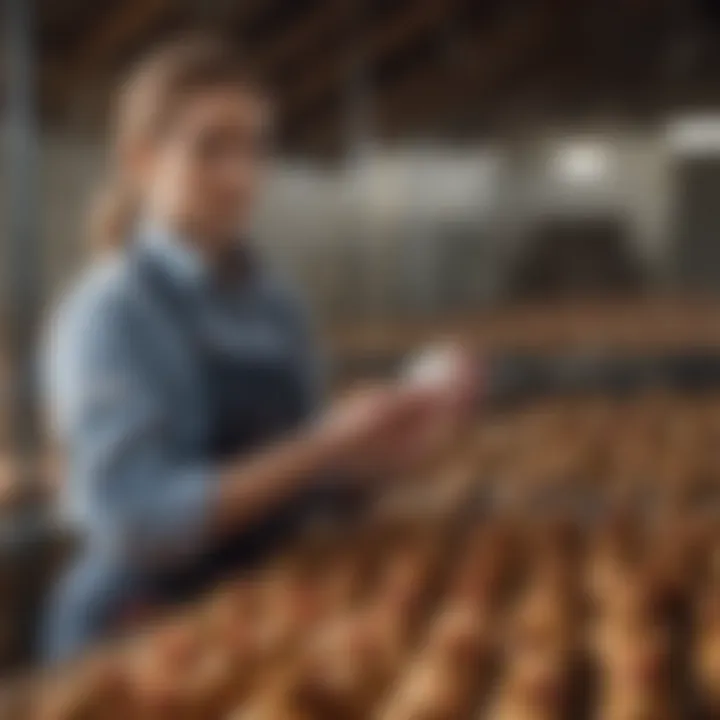
Toys and interaction serve as vital aspects of enrichment in the coop. They enhance the environment and keep the chickens engaged, therefore contributing to the overall goal of addressing egg eating.
The key characteristic of using toys involves providing items specifically designed for chickens such as swings or mirrors. These toys create stimulation and help alleviate repetitive behaviors.
Unique features include the social interaction fostered between chickens, especially in groups. This communal behavior can lead to a more balanced pecking order. One potential downside is that some chickens may be uninterested in toys, which requires continual adaptation of enrichment strategies to meet varying interests within the flock.
Monitoring and Evaluating Solutions
Monitoring and evaluating solutions is crucial in addressing the issue of egg eating in chickens. Keeping track of behavioral changes and adjusting management strategies based on results helps ensure that the interventions implemented are effective. This process not only identifies what is working but also highlights areas needing improvement. Proper evaluation facilitates better decision-making, promoting a healthy environment for the flock.
Tracking Behavioral Changes
Tracking the behavioral changes in chickens can offer insights into their well-being and may indicate the effectiveness of implemented strategies.
Regular Observations
Regular observations involve monitoring the chickens daily to note any changes in behavior related to egg eating. This method is beneficial because it helps to identify trends over time. Observing reliably can lead to a deeper understanding of the flock's habits and fluctuations in behavior. A key characteristic of this approach is consistency; by making it a routine task, keepers can better distinguish between normal behaviors and troubling signs.
However, one unique feature of regular observations is the potential depth of detail that can be gathered. With attention to specific behaviors, keepers could identify triggers for egg eating. The advantage here is that minute details can lead to early interventions, preventing a larger problem. But, this method requires commitment and time from the keeper, which can be a disadvantage for those with larger flocks or other responsibilities.
Egg Production Records
Egg production records provide a quantitative measure of the flock's productivity. Keeping these records allows poultry keepers to evaluate the rate of egg production over time. A key characteristic of egg production records is their objectivity; numbers speak clearly about the flock's health and productivity levels. This can be a beneficial choice because it offers a factual basis for identifying egg eating occurrences.
The unique feature of maintaining these records is that it allows trends to be established. By comparing data over weeks or months, keepers can see if there are transmission spikes in egg consumption. However, a possible disadvantage is the need for diligent record-keeping, which may be challenging for some.
Adjusting Strategies Based on Results
Adjusting strategies based on collected results is essential for ongoing management. After tracking behaviors and production, evaluating this data can guide how to modify interventions effectively.
Re-evaluating Nutrition
Nutrition is often a significant factor in poultry behavior, and re-evaluating nutrition should align with observed patterns from tracking tools. Assessing the diet can highlight nutritional gaps contributing to egg eating behaviors. This characteristic makes it a capable choice in the article because proper nutrition is foundational for health.
One unique aspect of this process is its focus on diet's variability; the keeper may trial different feed formulations. By measuring the effects of these changes, one can identify what works best for their flock. The advantage of optimizing nutrition is an improved overall response from the chickens. A potential disadvantage can be the complexity involved in sourcing or mixing feeds necessary for adjustments.
Modifying Environment
Modifying the environment involves changing physical setups where chickens are kept. This adjustment is vital because environmental factors can significantly influence behavior. A key characteristic of modifying the environment is its immediate impact; changes can be seen quickly. This choice is helpful because it can directly address stressors contributing to egg eating.
A unique feature here is the range of alterations that can be made—from spatial arrangements to adding enrichment features like new nesting areas. The advantage of this method is its potential for rapid improvement in flock behavior. However, the disadvantage may include the costs associated with modifying coop structures or the challenges of convincing chickens to adapt to new conditions.
In summary, monitoring and evaluating solutions foster a sustainable approach to managing egg eating. By systematically tracking behaviors and adjusting strategies based on results, poultry keepers can create a more resilient environment for their chickens, ultimately leading to improved health and productivity.
The End and Future Considerations
The issue of egg eating among chickens is multifaceted. Addressing this behavior includes understanding its causes, implementing strategic solutions, and evaluating their effectiveness over time. The conclusion wraps up the exploration of these elements, benefiting poultry keepers by clarifying the steps needed to manage the problem effectively. In addition, future considerations provide guidance on how to refine practices and remain informed about evolving research. This combination allows for a more proactive approach in creating a nurturing environment for chickens.
Summarizing Key Takeaways
The article has highlighted the various causes of egg eating in chickens, such as:
- Nutritional deficiencies, including low calcium or inadequate protein levels.
- Environmental stressors like overcrowding or poor coop conditions.
- Instinctual factors related to pecking order and nesting behavior.
Recognizing these aspects is crucial for any poultry keeper aiming to reduce the occurrence of this behavior. By monitoring for identifiable signs and making necessary adjustments to nutrition and environment, it is feasible to significantly diminish egg eating.
Potential Areas for Research
Research can lead to deeper understanding and more effective strategies in managing egg eating. Two pressing areas are:
Long-term Behavioral Studies
Long-term behavioral studies provide valuable data on the patterns of egg eating in chickens. A key characteristic of these studies is their ability to observe changes in behavior over extended periods. This is beneficial because it helps researchers identify whether interventions have lasting effects. A unique feature is their focus on external variables affecting behavior, which can reveal insights into stress or environmental factors influencing egg consumption. These studies have the advantage of accumulating vast datasets but can be time-consuming and resource-intensive.
Enhanced Nutritional Insights
Enhanced nutritional insights involve examining how different diets impact chicken behavior and health. A fundamental characteristic of this approach is its focus on nutrient optimization. This makes it a popular choice since proper nutrition is essential for overall flock well-being. The unique feature of enhanced nutritional insights lies in exploring novel feeding strategies or additives that prevent egg eating. One advantage is the potential for substantial improvements in chicken health; however, costs may escalate with specialized feeds and supplements.
Understanding these areas of future research can lead to effective strategies, helping keepers manage their flocks more sustainably while addressing the pressing concern of egg eating.



